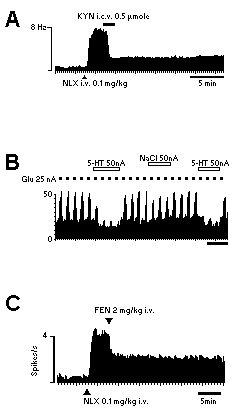
| Figure 1. |
 |
| A: Intracerebroventricular injection of the excitatory amino acid antagonist kynurenate (KYN) (0.5 mmol in 5 ml) strongly attenuated the withdrawal hyperactivity of LC neurons precipitated by intravenous naloxone (NLX: 0.1 mg/kg). (From ref. 3.) B: Computer-generated integrated activity–time histograms, revealing interactive effects of 5-HT and Glu on LC discharge. Pulses of Glu (applied at solid bars) activate a typical LC neuron. Co-iontophoresis of 5-HT (applied at open bars), but not of saline (applied at stippled bar), attenuates Glu response but has little effect on basal discharge. (From ref. 7.) C: Effects of intravenous administration of the indirect 5-HT agonist d-fenfluramine (FEN) on the activity of LC neurons during opiate withdrawal. Ratemeter record illustrating the attenuation of withdrawal-induced activation of LC neurons by d-fenfluramine. d-Fenfluoramine (2 mg/kg i.v.) strongly but incompletely reversed the activation of this typical LC neuron following morphine withdrawal precipitated by i.v. naloxone (0.1 mg/kg). (From ref. 4.) |
published 2000